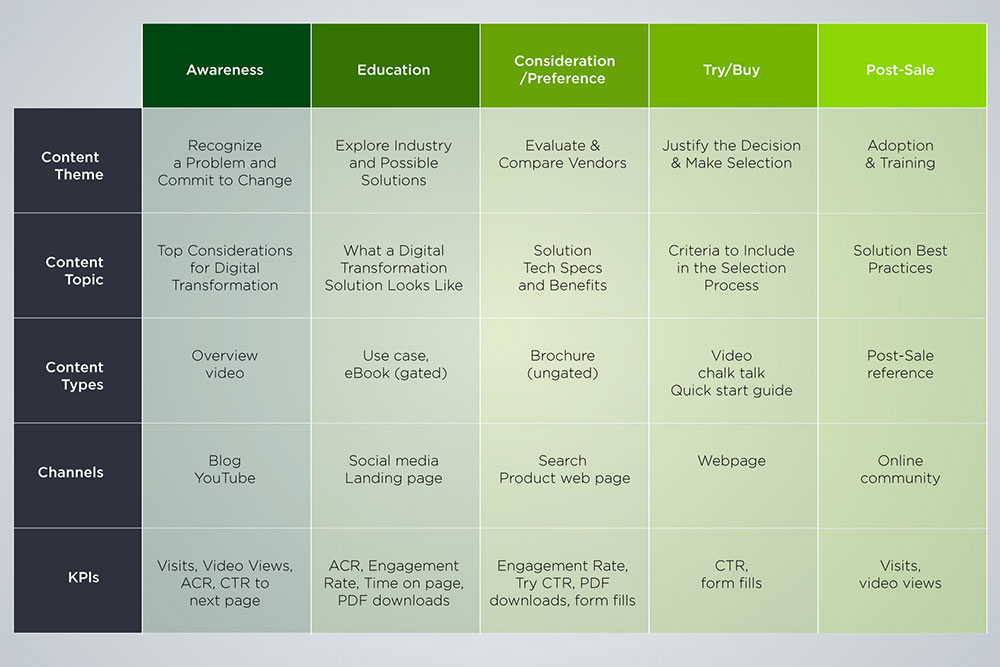Too often, B2B marketers get caught up in the daily grind—putting out fires and reacting to last-minute requests—while neglecting to devote the necessary time and effort required to create their annual content marketing plan. You know—that critical document that lays out the tactics you will activate throughout the year to meet your goals.
Without a comprehensive plan, your strategy is a vision that will never be realized. Whether you are guilty of putting off your planning process (you’re not alone) or you’re committed to prioritizing it this go ’round, make sure that your content marketing plan includes these five essential elements for success.
A Strategy Without a Plan Is Like a Car Without Wheels
According to the Content Marketing Institute’s B2B Content Marketing Benchmarks, Budgets, and Trends research, top-performing B2B marketers rate their content strategy as extremely or very effective. And yet only 47% of those organizations attribute their success to having a formally documented strategy—aka a plan.
Let’s be clear: A content marketing strategy is critical for achieving business goals—from reaching new customers to driving growth—in our digitized world. But the content marketing plan is where the rubber meets the road. So don’t phone in your plan. Without it, your strategy could falter and fail.
That said, the contents of a marketing plan should address the fundamental questions of: What do we do? For whom do we do it? When do we do it? How do we succeed?
To help you answer these questions, we’ve provided the following five essentials to include in your plan:
- Audience: the persona you are targeting for your content marketing efforts
- Tactics: the content strategy deliverables you create and the content distribution methods you will use
- Timeline: the dates for development and launch of your campaigns and programs
- Resources: the budget, people, and processes required to execute your plan
- Metrics: the results of your content marketing tactics
Essential Element #1: Target Audience(s)
A well-designed content marketing plan centers on the audience you’re trying to reach, educate, and engage with your content marketing efforts. It should answer the following questions:
- Whom do you need to reach and influence to achieve your business goals?
- How does your target audience become aware of brands in your category?
- What does their purchase journey look like?
- What/who are their key influencers when making a purchase?
Essential Element #2: Tactics
To activate your content marketing strategy, you’ll need to determine the winning combination of content and distribution channels that will advance your audience through the buyer journey stages. First, identify the primary themes for your content and the topics that align with them. Then, add in the content types and channels that will shape your editorial plan.
Think of your content types and channels as the tactics that become the engine of your content marketing plan. There are lots of moving parts and together they build momentum to move you closer to your goal. Here’s an example:

Planning tip: Organize your plan around your “big rocks”—the high-priority initiatives that will have the greatest impact on your business goals. Examples of “big rocks” include multi-channel thought leadership campaigns, major product launches, and large corporate or industry events.
Essential Element #3: Timeline
The timeline for your content deliverables is critical. It should include dates for big milestones such as a campaign launch, new product announcement. or a company event.
Your content marketing plan should align with your company’s budget cycle. For most companies, this spans 12 months. Whether you structure your plan by weeks, months, or quarters, a content marketing calendar is imperative to keep track of deliverables, lead times, and deadlines.
Planning tips:
- Bake in lead times for development and production phases to ensure you have adequate resources to support your plan. This will minimize the risk of workload and bandwidth issues that can quickly derail your timeline (for example, if your team is stretched thin because they are working on other projects).
- Seasoned marketers know all too well that unexpected announcements, organizational changes, or other events can throw off a timeline. Review and update your timelines regularly and embrace change when it happens. And always have a Plan B in your back pocket.
Essential Element #4: Resources
Securing key resources is the most challenging aspect of building an annual content marketing plan. It’s common for organizations to spend months hashing out budgets and headcount, which can ultimately delay the completion of the plan—sometimes well into the new fiscal year. As a result, many marketers find themselves developing a plan while waiting for the final word on the annual budget.
As a best practice, include these placeholders in your plan:
- People: Who will be leading your marketing initiatives and programs? Who will be supporting them (e.g., contractors, other employees).
- Process: What tools or marketing platforms will you need to automate processes?
- Budget: What is the estimated cost to create or update your content? What marketing channels will require budget (e.g., paid search, paid social)? If you are outsourcing content development, what will it cost? If you need to purchase a new marketing platform, what will it cost? What budget do you want to allocate for pilot programs or testing?
Planning tip: While you are waiting for the final word on your marketing budget, prioritize your content deliverables and identify them as high-, medium-, or low-priority in your plan. When you receive your approved budget number, you can easily cut out the lower-priority items and hit the ground sprinting with your funded tactics.
Essential Element #5: Metrics
It’s crucial to include a section in your content marketing plan to show how you are measuring success. You will be happy you did this when your executive team starts asking for a progress report. Best to have baked this into your plan at the start than needing to scramble for metrics the night before your business review meeting.
Planning tip: Don’t try to include every single metric that can be tracked. Narrow your list of metrics to what is most important to your key stakeholders for gauging progress. Ideally, you should have two to three metrics for each goal.
Ready, Set, Create Your Content Marketing Plan
Now that you know the essential elements to include in your plan, you’ll be ready to take on the opportunities and challenges the coming year will bring. Nothing boosts a content marketer’s confidence like a meticulous plan that’s designed to maximize marketing efforts and achieve business success.
Get Content Strategy and Planning Support from Tendo
Count on Tendo’s content strategy and planning and content marketing services to design and deliver stellar content experiences that help you reach your goals. Our expert team has helped leading B2B brands connect with and convert their target audiences. Contact us today.
First published December 8, 2021









